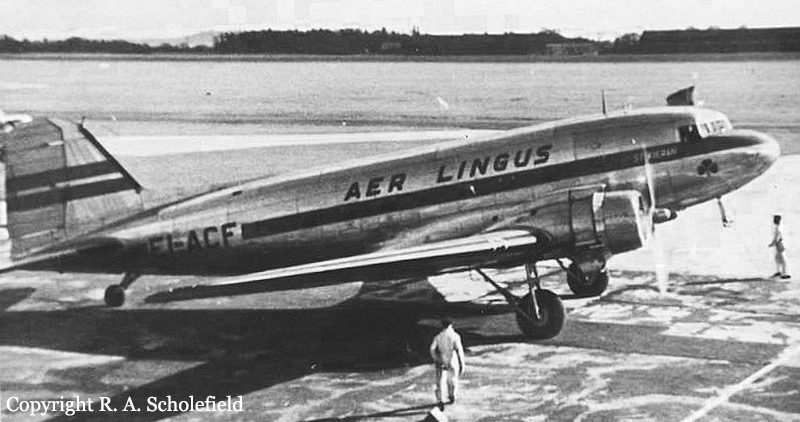Country
Operator Image

Crash of a Short 360-100 in East Midlands
Date & Time:
Jan 31, 1986 at 1851 LT
Registration:
EI-BEM
Survivors:
Yes
Schedule:
Dublin - East Midlands
MSN:
3642
YOM:
1984
Flight number:
EI328
Crew on board:
3
Crew fatalities:
Pax on board:
33
Pax fatalities:
Other fatalities:
Total fatalities:
0
Captain / Total hours on type:
123.00
Copilot / Total hours on type:
1240
Aircraft flight hours:
3226
Circumstances:
The Shorts 360 aircraft was scheduled to fly from Dublin (DUB) to East Midlands Airport (EMA) as Aer Lingus flight 328. During the pre-flight briefing the crew learned that at East Midlands the precision radar was unserviceable and that, although the visual approach slope indicators (VASI) had been withdrawn, the precision approach path indicators (PAPI) were operational. The en-route weather was reported as being overcast for the whole journey, with cloud tops at FL70 and a probability of icing when flying in the cloud. There had also been a pilot's report of severe icing between FL30 and FL70 in the Birmingham area, some 30 nm south-west of East Midlands Airport. The terminal area forecast for East Midlands suggested a brisk north-easterly wind and a cloud base of 1200 feet. The aircraft took off at 17:25. The crew report that they exercised the wing and tail de-icing system during the climb to FL 90, the level which had been assigned for the flight, and that at that level they were above the layers of stratiform cloud. Following an uneventful flight, via Wallasey, to the NDB at Whitegate, they were taken under radar control directly towards the airport and given descent clearance, eventually to 3000 feet, to intercept the ILS approach path for runway 09. During the descent and before entering the cloud tops at about FL60, the crew switched on the aircraft's anti-ice system, which heats the windscreen, engine air intakes, propellers, static air vents and pitot probes but, in accordance with normal operating procedure, they did not use the wing and tail de-icing system. At this time, the freezing level (0°C isotherm) was at 1000 feet, the temperature at FL 60 was minus 6°C and the air was saturated. Whilst in the cloud, which according to the non-handling pilot was particularly dense, ice thrown from the propellers was heard striking the side of the aircraft fuselage, and it was suggested that the propeller rpm be increased to expedite the removal of the ice. Both pilots state that, at some time during the descent, they visually checked the aircraft for ice but saw none. Nevertheless, several other flights during that evening have since reported the occurrence of severe icing. Having levelled at 3000 feet, still in and out of cloud, the aircraft was directed by radar to intercept the ILS and was fully established on the glideslope and centreline by 10 nm, at which point the final descent was initiated. A normal approach was established and continued, past the outer marker beacon situated at 3.9 nm from touchdown, down to around 1000 feet above the runway threshold height. The crew state that up to this point they had neither experienced any significant turbulence nor observed any ice forming on the aircraft. The last meteorological information passed to the crew gave the wind as 060 degrees /15 kt, however, over the previous hour the wind speed in the area, although not automatically recorded at the airport, is reported as gusting up to 30 kt. As the aircraft descended through about 1000 feet, it suddenly rolled very sharply to the left without apparent cause. With the application of corrective aileron and rudder the aircraft rolled rapidly right, well beyond the wings level position. This alternate left and right rolling motion continued with the angles of bank increasing for some 30 seconds, causing the commander to believe that the aircraft might roll right over onto its back. The angles of bank then gradually decreased. During this period and the subsequent few seconds the aircraft established a very high descent rate approaching 3000 feet/min. Subsequently, with the aid of full engine power, the airspeed increased and the rate of descent was arrested just as the aircraft struck an 11 KV power cable. It continued through another similar cable, two of the supporting wooden poles and the tops of two trees, before coming to rest nose into a small wood edging a field of barley, some 460 metres from the impact with the first power cable. The cockpit and passenger cabin were relatively undamaged and there was no fire. The aircraft came to rest lying virtually upright and the passengers, and subsequently the crew, successfully evacuated from the front and rear emergency exits.
Probable cause:
The accident most probably occurred as a result of the effects of a significant accumulation of airframe ice degrading the aircraft's stability and control characteristics, such that the crew were unable to maintain control. Turbulence and or downdraught may have contributed to the accident. Other contributory factors were the difficulty in detecting clear ice at night on the SD3-60 which resulted in the airframe de-icing system not being used. The delay in application of go-around power may have also contributed to the accident.
Final Report:
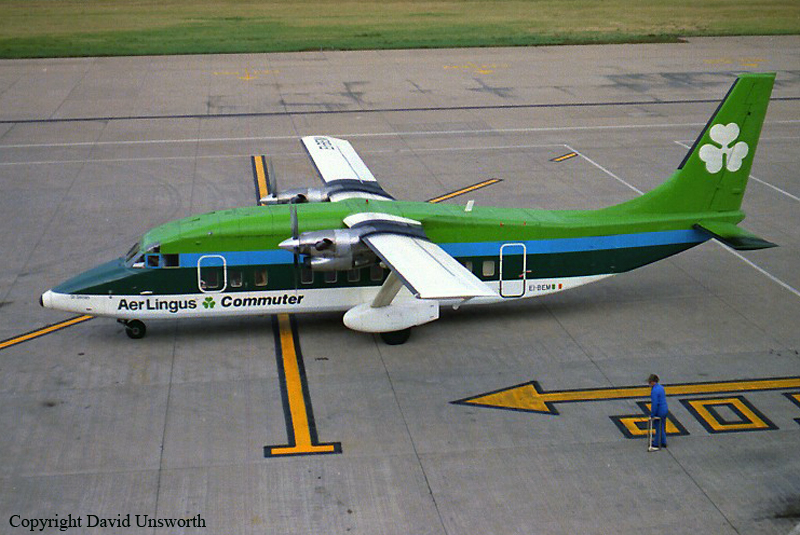
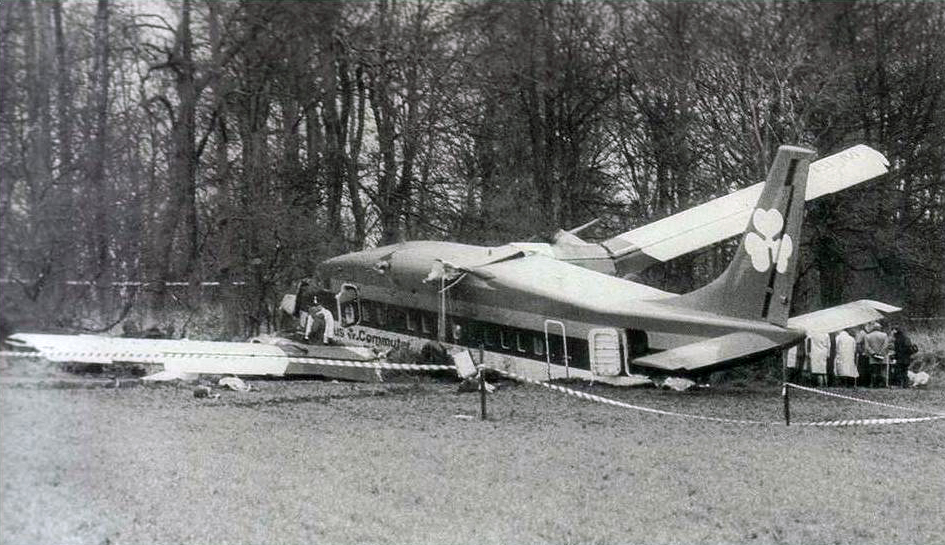
Crash of a Vickers 803 Viscount off Wexford: 61 killed
Date & Time:
Mar 24, 1968 at 1058 LT
Registration:
EI-AOM
Survivors:
No
Schedule:
Cork - London-Heathrow
MSN:
178
YOM:
1957
Flight number:
EI712
Crew on board:
4
Crew fatalities:
Pax on board:
57
Pax fatalities:
Other fatalities:
Total fatalities:
61
Captain / Total hours on type:
1679.00
Copilot / Total hours on type:
900
Aircraft flight hours:
18806
Aircraft flight cycles:
16923
Circumstances:
Viscount aeroplane type 803, registration: EI-AOM departed from Cork Airport at 10.32 hours en route for London operating as Aer Lingus Flight 712. The take-off was normal. The flight was cleared by Air Traffic Control to proceed via Airways Blue 10, Green 1 at flight level 170 (17,000'). At 10.38, when the aeroplane had passed through 7,000', clearance on course to Tuskar was given. At 10.40, after the flight had reported it was by Youghal at 7,500' climbing to 17,000', ATC Cork suggested that if desired, the flight could route direct to Strumble. No direct acceptance of this suggestion was received. At 10.57.07 the flight reported "by Bannow (a reporting point on the route at 51º 68' N - 06º 12' W) level 170 (17,000') estimating Strumble at 03". The flight was instructed to change to the London Airways frequency of 131.2, and this was acknowledged by the reply "131.2". The time of this call was 10.57.29. At 10.58.02, London Radar intercepted a call (garbled and simultaneous with another call) which appeared to be, and was later confirmed as "Echo India Alpha Oscar Mike with you", and eight (8) seconds later, a call was intercepted which was interpreted as "Five thousand feet descending spinning rapidly". This call was also heard by another Aer Lingus aircraft en route Dublin-Bristol (The word "Five" was later, after repeated acoustic analysis, interpreted as more likely to be the word "twelve".) This was the last call received from the aircraft. At 11.10, London ATC advised Shannon ATC that they had no radio contact with EI-AOM. At 11.13 London advised Shannon that they had requested Aer Lingus Flight EI 362 (Dublin-Bristol) to search west of Strumble. This flight descended to 500' in good visibility, but saw nothing. Between 11.13 and 11.25, efforts were made to make radio contact with the flight, with no result, and at 11.25 a full alert was declared. At 12.36 a report from the U.K. was received by Haulbowline that wreckage had been sighted in position 51º 57' N, 06º 10' W Rosslare Lifeboat was proceeding, but two surface vessels within 4 nautical miles of this position saw nothing. At 12.52 hours the Air Corps reported that they had dispatched a Dove aeroplane and a helicopter to search. At 13.10 hours there were ten aircraft from the U.K. in the search area. At 15.30 hours the reported sighting of wreckage was cancelled. Nothing positive was discovered on this day. On 25 March 1968, at 06.15 hours, the search was resumed by aircraft and ships from the U.K., and at 12.41 hours, wreckage was sighted and bodies recovered from a position 6 nautical miles north-east of Tuskar Rock. More floating wreckage was reported scattered for a further 6 nautical miles north-west of this point. The Irish Naval Service ship, L.E. Macha, which had been on patrol off the north-west coast, joined in the search on 26 March 1968, and took over duty as Search Controller. A total of 13 bodies was eventually recovered in the search during the next few days, together with a quantity of light floating wreckage-mostly cabin furnishings, and some baggage, seat cushions, and the wheels and inner cylinder from the port main landing gear. One additional body was recovered later. The position of the main wreckage remained obscure in spite of prolonged and diligent search by sonar equipped ships of the British Navy and trawling by Irish trawlers-"Glendalough" from Kilmore Quay and "Cu na Mara" of the Irish Fisheries Board (An Bord Iascaigh Mhara). Eventually, on 5 June 1968 "Glendalough" hauled in position 1.72 nautical miles from Tuskar Rock with Tuskar bearing 280º, in 39 fathoms and brought up a quantity of positively identifiable wreckage. The "Cu na Mara" in the same location also brought up wreckage. On the following day more wreckage was brought up by these trawlers, and divers from H.M.S. Reclaim confirmed a mass of wreckage "like a scrap yard" in this position. Subsequent salvage operations confirmed that a major portion of the aircraft at least was located here. Two eyewitnesses, one a sailor on a coastal vessel, who thought he had seen an aircraft crash into the sea but did not report it at the time, and another witness on shore, who saw a splash in the sea near the Tuskar Rock, gave the time as between 11.10 and 11.15. The position lines of these two witnesses approximately cross the location where the main wreckage was eventually found. The aircraft was totally demolished by violent impact with the sea. The bulk of the wreckage was found in 39 fathoms of water with all parts lying in close proximity. About 60-65% of the aircraft (by weight) was recovered, and included the major parts of three engines, a few parts of the fourth, and all four propellers, the almost complete primary structure of the wings from tip to tip, and the fin and rudder. None of the wreckage displayed any evidence of fire or explosion. No part of the tail planes or elevators were recovered, with the exception of small portions of the spring tab and trim tab. The recovered wreckage revealed extensive damage to the whole structure, which virtually disintegrated.
Probable cause:
There is not enough evidence available on which to reach a conclusion of reasonable probability as to the initial cause of this accident. The probable cause of the final impact with the sea was impairment of the controllability of the aircraft in the fore and aft (pitching) plane. Speculation continued since the time of the accident, prompted by a hypothesis posed in the report, that the Viscount may have been initially upset by the possible presence of another airborne object, drone or missile in its vicinity at the time. On the 30th anniversary of the accident, following newspaper articles and television programmes focusing on the possible involvement of U.K ships and missile ranges on the Welsh Coast in the downing of the aircraft, it was decided that Irish and U.K. officials would review all files held relating to the accident to see if the cause of the accident could be established. It was a.o. concluded that "the possibility of a cause other than a (near) collision with another airborne object being the initial cause of the upset ... does not appear to have been adequately examined in the 1970 Report." Following the review, in July 2000, the Irish Minister for Public Enterprise commissioned an independent study of the accident circumstances. The International Study Team published their findings in December 2001:
- An initial event, which cannot be clearly identified, disturbed the air flow around the horizontal tail surfaces and the pitch control of the aircraft. In the light of what was observed by non-skilled people there was a strong indication that structural fatigue, flutter, corrosion or bird strike could have been involved,
- It is possible that the sensitivity of the engine fuel control units to negative accelerations imposed during the initial upset, had an adverse effect on the subsequent flight path of the aircraft,
- The severe manoeuvres of the aircraft following the initial upset and the subsequent flight would have been outside the airworthiness certification envelope and may have resulted in some deformation of the structure,
- A number of possible causes for an impairment of pitch control were examined and it is considered very possible that excessive spring tab free play resulted in the fatigue failure of a component in the tab operating mechanism thus inducing a tailplane-elevator tab free flutter condition,
- The loads induced by the flutter condition would be of sufficient magnitude and frequency to cause a fatigue failure of the port tailplane within the timescale estimated for EI-AOM,
- There was no involvement of any other aircraft or missile.
- An initial event, which cannot be clearly identified, disturbed the air flow around the horizontal tail surfaces and the pitch control of the aircraft. In the light of what was observed by non-skilled people there was a strong indication that structural fatigue, flutter, corrosion or bird strike could have been involved,
- It is possible that the sensitivity of the engine fuel control units to negative accelerations imposed during the initial upset, had an adverse effect on the subsequent flight path of the aircraft,
- The severe manoeuvres of the aircraft following the initial upset and the subsequent flight would have been outside the airworthiness certification envelope and may have resulted in some deformation of the structure,
- A number of possible causes for an impairment of pitch control were examined and it is considered very possible that excessive spring tab free play resulted in the fatigue failure of a component in the tab operating mechanism thus inducing a tailplane-elevator tab free flutter condition,
- The loads induced by the flutter condition would be of sufficient magnitude and frequency to cause a fatigue failure of the port tailplane within the timescale estimated for EI-AOM,
- There was no involvement of any other aircraft or missile.
Final Report:
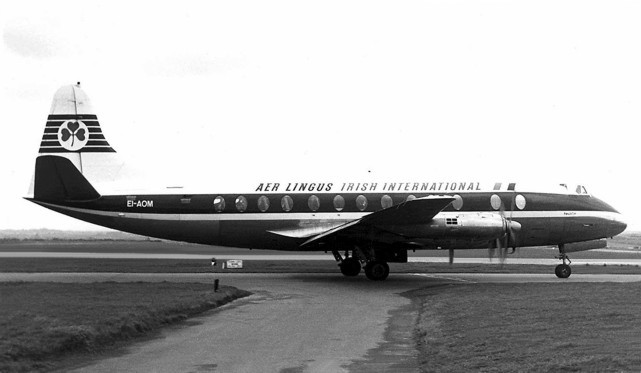
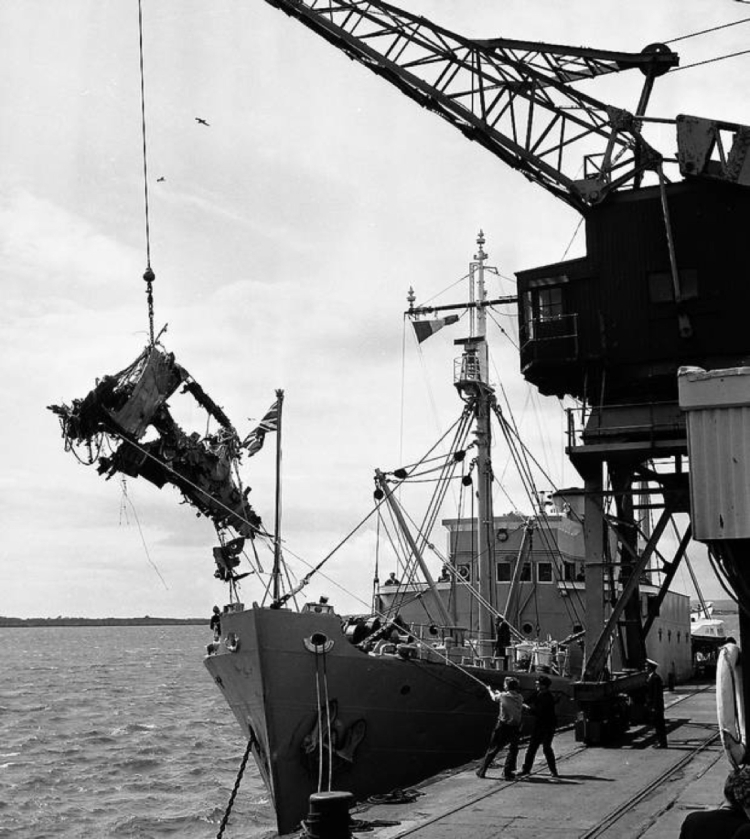

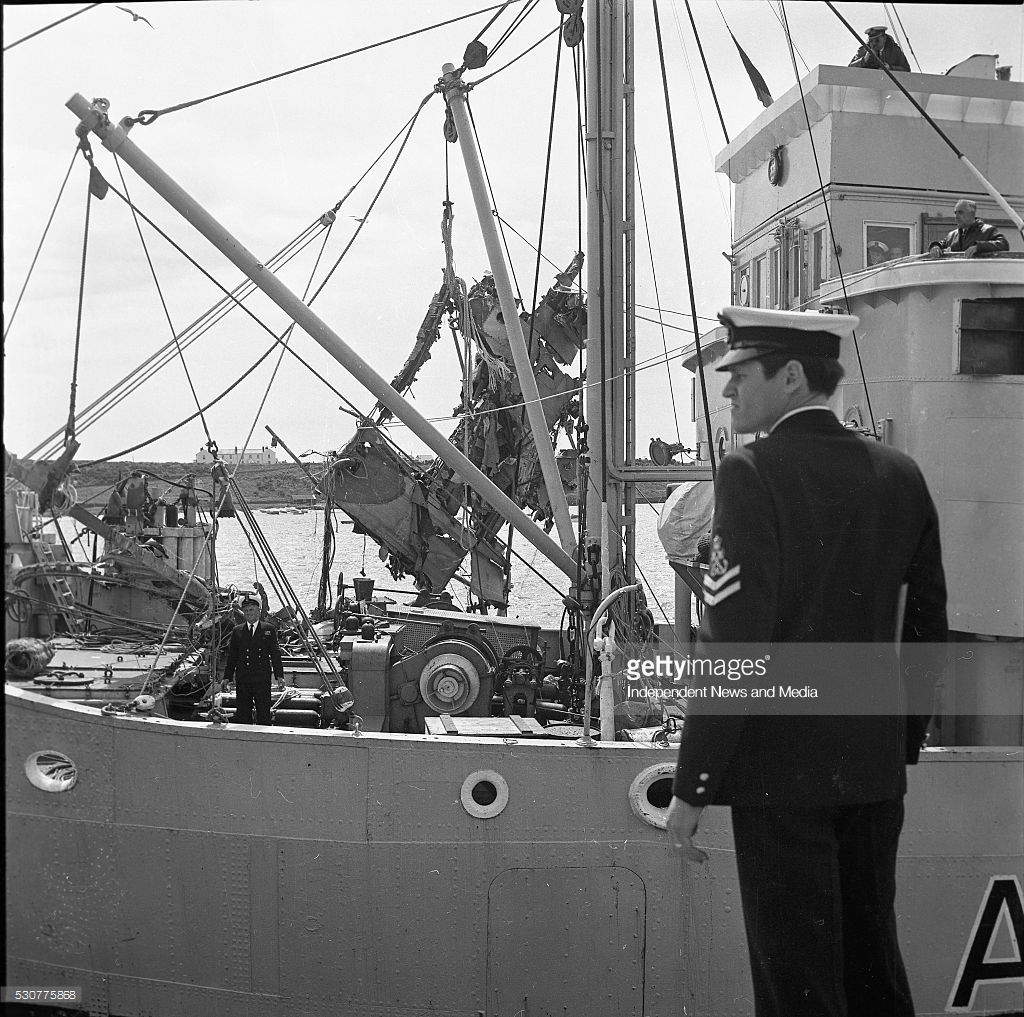
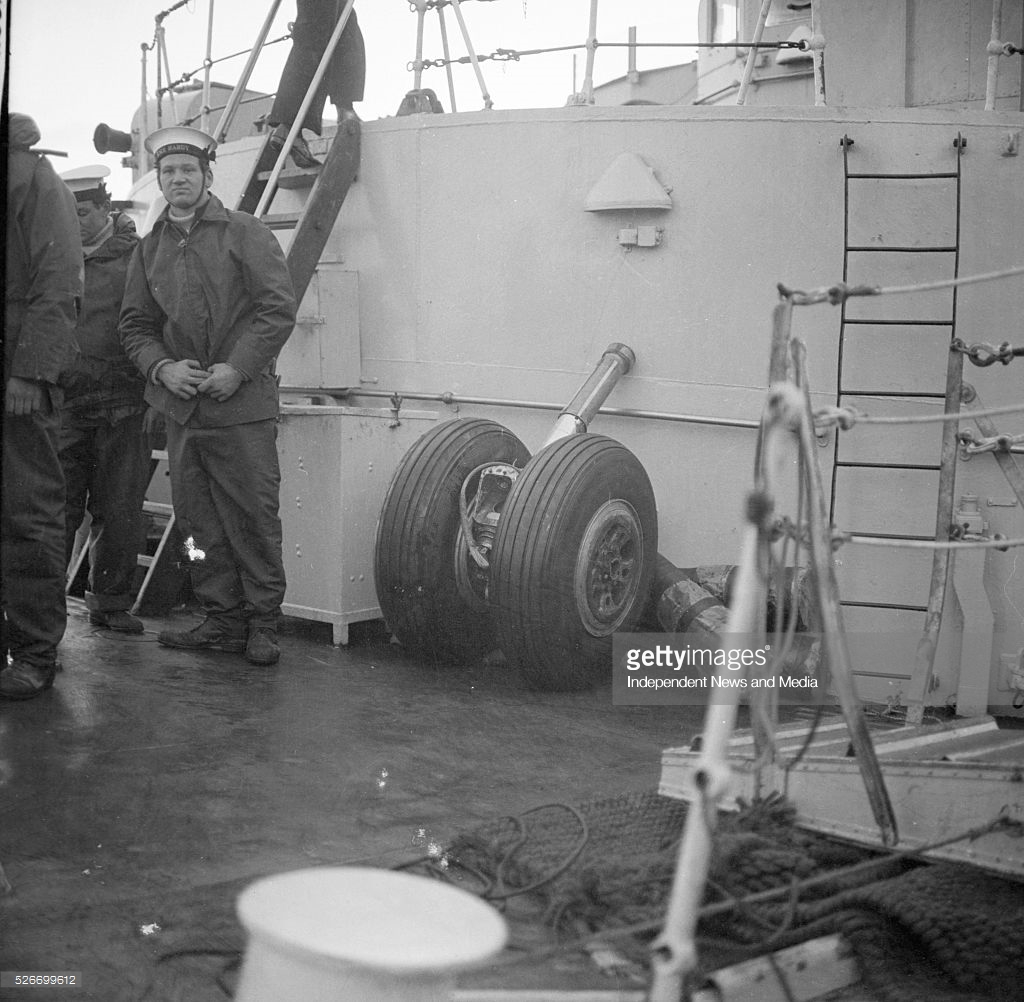
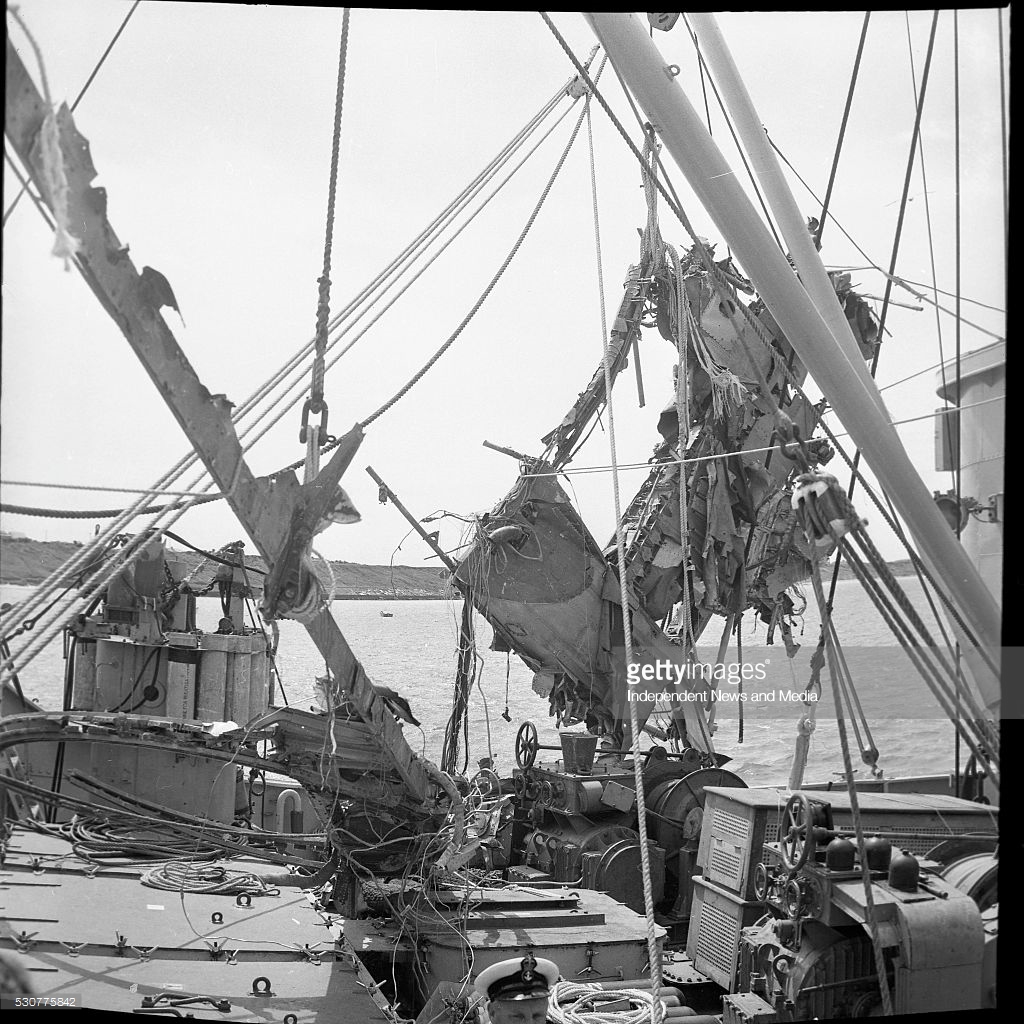

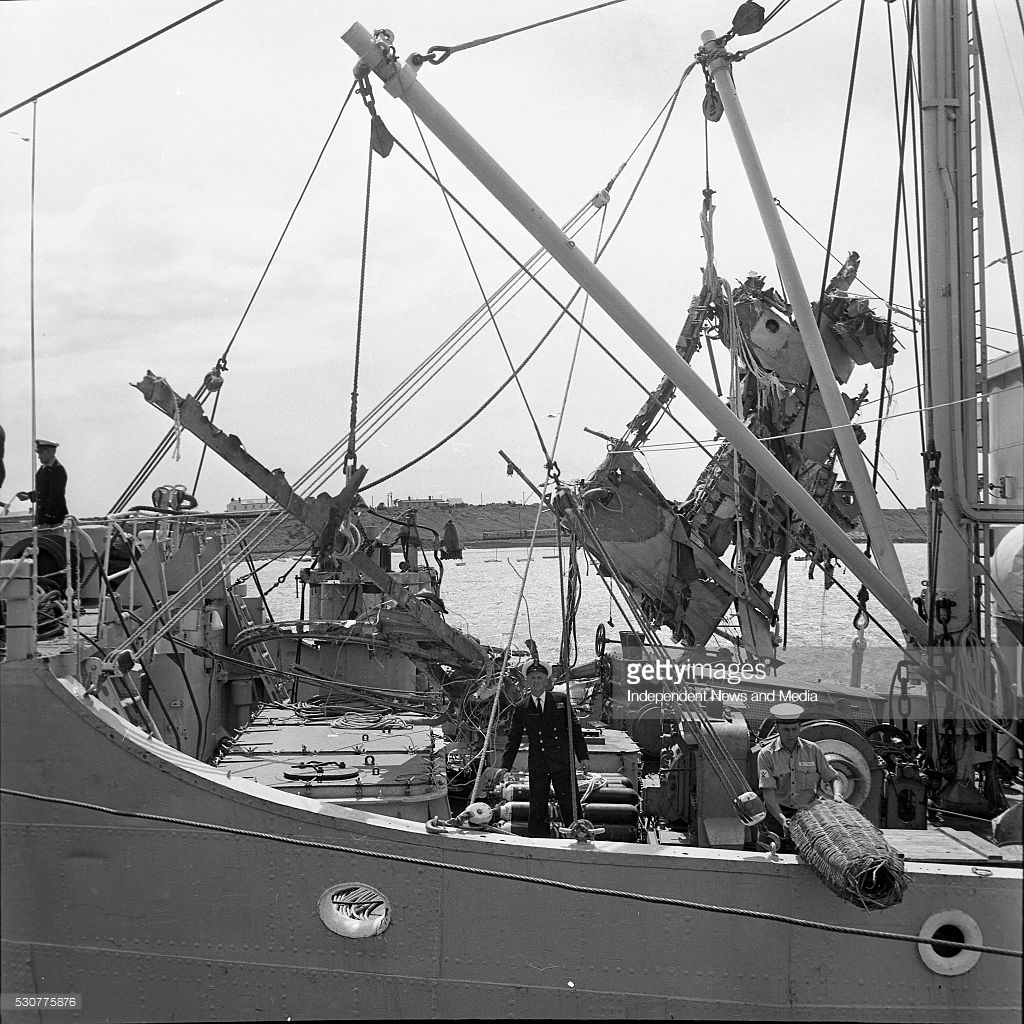

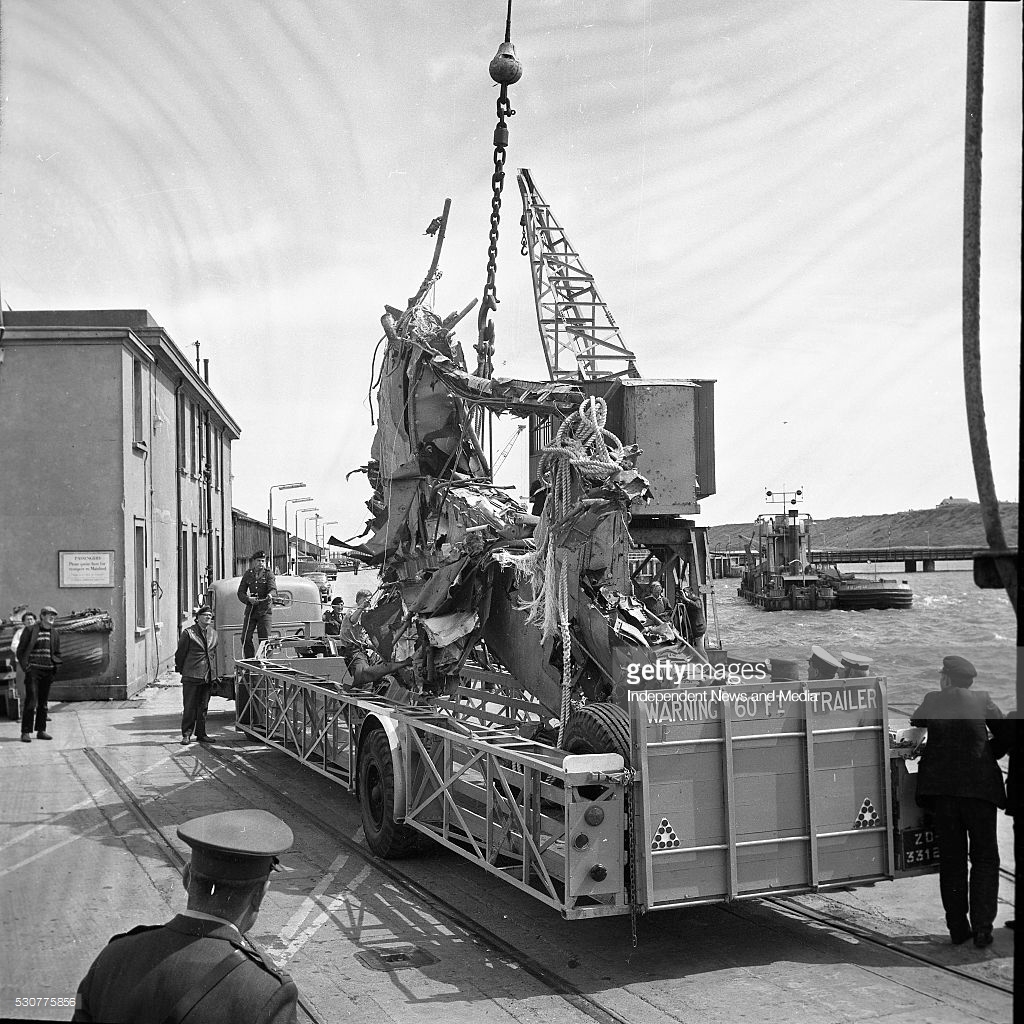
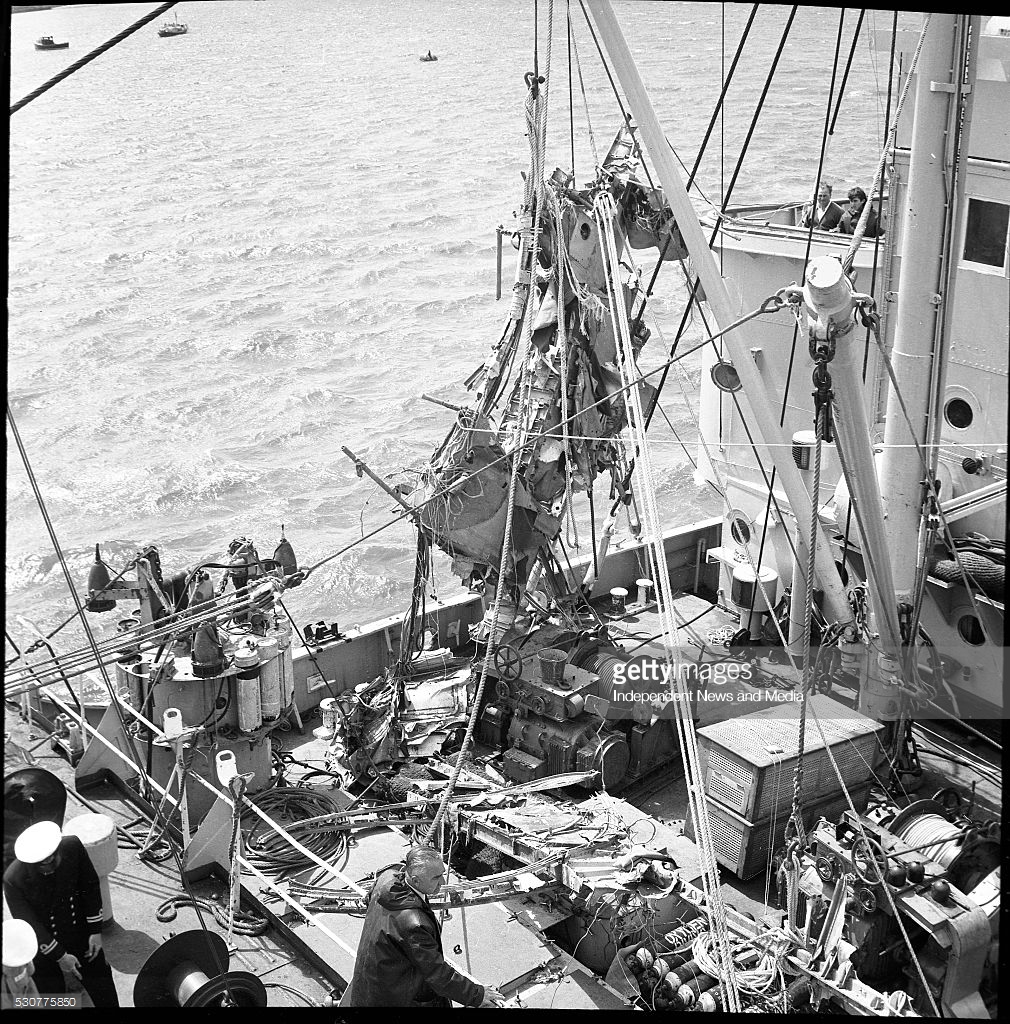

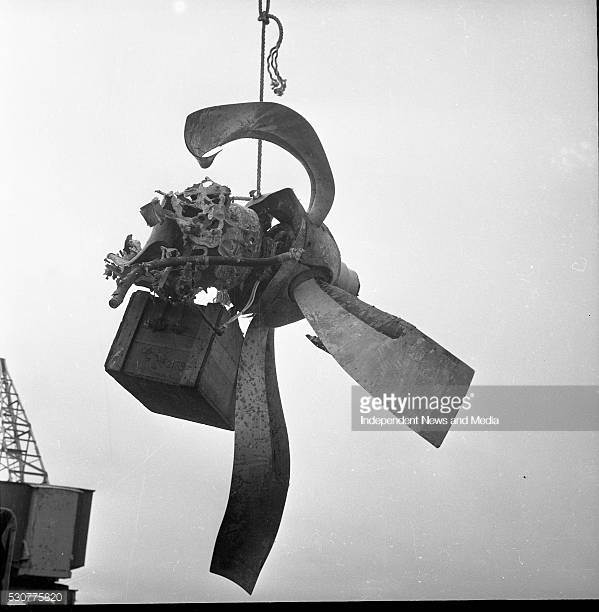
Crash of a Vickers 808 Viscount in Bristol
Date & Time:
Sep 21, 1967 at 0859 LT
Registration:
EI-AKK
Survivors:
Yes
Schedule:
Dublin - Bristol
MSN:
422
YOM:
1959
Crew on board:
4
Crew fatalities:
Pax on board:
17
Pax fatalities:
Other fatalities:
Total fatalities:
0
Captain / Total hours on type:
1300.00
Copilot / Total hours on type:
592
Aircraft flight hours:
18375
Circumstances:
Before leaving Dublin no landing forecast for Lulsgate was available but the forecast conditions for Filton, 10 miles north of Lulsgate, were well above the company minima of 260 ft critical height and 800 rn RVR. About 25 minutes before commencing the approach to land and whilst the aircraft was on the airway near Strumble, the latest weather conditions for Lulsgate obtained by radio from air traffic control, showed that there was 3/8 cloud at 1 000 ft, visibility was 1 500 m with the sun tending to disperse cloud and mist. After leaving the airway, the aircraft was positioned by Lulsgate radar for an approach to runway 28 on a right-hand base leg. At 0752 hours GMT before the final approach was commenced, the latest weather conditions were passed by the Lulsgate rabar controller who was also the approach controller, these conditions showed a surface wind northerly 8 to 10 kt, QFE 979, QNH 1 001, visibility in mist 1 800 m. During the final turn on to the approach at 6 miles, the aircraft drifted to the left of the extended centre line which was regained closing from left to right during the final descent. At five miles from touchdown, still to the left of the centre line, a descent from 1 500 ft (QFE) was commenced at a rate of 300 ft per mile with advisory altitudes being passed every half mile. The air was calm and the commander was able to achieve a high degree of precision during the approach; heights were accurately flown during the descent and the aircraft's track, cow verging on the centre line, was steady, When the aircraft was between 3 and 34 miles from touchdown, the controller informed it that visibility had deteriorated to 1 200 m. At two miles, when steering 2950, the aircraft intercepted the approach centre line and its heading was corrected to 290°; at one and a half miles at 500 ft, a further heading correction was made on to 287°. A drift to the right, away from the centre line, became apparent when the aircraft was between 1 and 12 miles from touchdown and the controller gave further corrections to the left to 285° and 280°. At one mile from touchdown at 350 feet, a further left correction to 275° was given but the aircraft continued to track to the right of the centre line. At half a mile from touchdown, when the talk-down was complete, the controller informed the aircraft it was well to the right of the centre line and that it should overshoot if the runway was not in sight. Shortly afterwards the aircraft was seen, by a controller, heading towards the control tower before commencing its corrective turn to the left. The commander, who was at the controls of the aircraft, said it was possible to refer to the ground and natural horizon until passing through about 650 ft when a thin layer of cloud followed by misty conditions required the remainder of the approach to be made on instruments. Whilst descending through 300 ft, the commander asked the co-pilot if he could see anything but just as he replied in the negative the commander saw the approach lights ahead and to his left and he promptly commenced an 'St turn to line up with them. As he did so he called for 400 of flap and less power in order to reduce the airspeed from 130 kt to about 112 kt. During this phase, he lost contact with the lights "for some seconds" but he elected to continue the approach because the last reported visibility was 1 200 rn and he was confident the runway lights would shortly appear ahead. When they came into view the aircraft was over the left-hand side of the runway and not properly aligned with it; the commander said he attempted to turn on to the runway centre line as he flared out for the landing. During this manoeuvre, although he was not aware of it, the starboard wing tip and No. 4 propeller struck the runway; the aircraft then touched down on all its wheels with considerable port drift. The commander took overshoot action, applying full power, calling for 20° of flap and the undercarriage to be raised; the airspeed had, in the meanwhile, fallen below 100 kt. The commander realised that the aircraft was not accelerating normally and saw that it was headed towards buildings on the northern perimeter of the aerodrome; rather than risk flying into these obstructions, he flew the aircraft on to the ground with its undercarriagi retracting. The aircraft touched down starboard wing first, ground-looped tb the right as it slid along the remaining section of the adjacent runway, then crashed tail first through a fence. Ten of the occupants of the passenger cabin were injured, three of them seriously; fire did not break out; rescue and fire vehicles arrived promptly on the scene. The accident occurred at 0759 hours.
Probable cause:
The accident was caused by an attempt to align the aircraft with the runway at too low a height following the commander's incorrect decision to continue the approach when visual guidance became obscured below critical height. A crash landing became necessary during an attempted overshoot after the aircraft had touched the ground and sustained damage during a turn at a low height.
Final Report:
Crash of a Vickers 803 Viscount in Ashbourne: 3 killed
Date & Time:
Jun 22, 1967 at 0835 LT
Registration:
EI-AOF
Survivors:
No
Schedule:
Dublin - Dublin
MSN:
176
YOM:
1957
Crew on board:
3
Crew fatalities:
Pax on board:
0
Pax fatalities:
Other fatalities:
Total fatalities:
3
Aircraft flight hours:
17447
Circumstances:
The Viscount had departed Dublin at 06:44 GMT for a pilot conversion training flight on an IFR flight plan. The instructor planned to spend 2 hours in a sector NW of Dublin, followed by practicing circuits and landings for one hour. Eyewitnesses reported seeing the aircraft entering a vertical dive from low altitude. The plane crashed and caught fire. All three crew members were killed.
Source: ASN
Source: ASN
Probable cause:
An unintentional stall and incipient spin at a low altitude from which recovery was not possible. There is not enough evidence to determine the circumstances leading to the stall and incipient spin but the behaviour of the aircraft in the final stages was such as to indicate that it was not under control of the flight instructor.
Crash of a Douglas DC-3D in Spernall
Date & Time:
Jan 1, 1953 at 1100 LT
Registration:
EI-ACF
Survivors:
Yes
Schedule:
Dublin – Birmingham
MSN:
42957
YOM:
1946
Crew on board:
3
Crew fatalities:
Pax on board:
22
Pax fatalities:
Other fatalities:
Total fatalities:
0
Captain / Total hours on type:
3369.00
Copilot / Total hours on type:
2668
Aircraft flight hours:
10968
Circumstances:
Christened 'St Kieran', the aircraft left Dublin at 0936LT Bound for Birmingham, carrying 22 passengers and a crew of three. While cruising at an altitude of 5,000 feet, both engines lost power. The crew decided to make an emergency landing and the aircraft came to rest in a field located in Spernall. It was damaged beyond repair while all 25 occupants were evacuated safely, except for the copilot who was injured.
Probable cause:
The primary cause of the accident was loss of engine power due to fuel starvation. The Inquiry found that this was caused by selecting the port engine to the right main tank to which the starboard engine was also selected. The loss of engine power alone was the sole cause of the accident, which could have been avoided had the crew diagnosed the cause of the trouble and changed the fuel feed to another tank. The failure to diagnose fuel starvation was probably due to the circumstances: i.e. first, the lack of coordinated effort by the Captain and First Officer after the engines cut; second, the knowledge of the crew that ample fuel for the flight was on board and their belief that the engines were drawing from their respective main tanks. The actual forced landing of the aircraft in conditions of low cloud, poor forward visibility and unfavorable terrain was skilfully executed and resulted in the passengers escaping unharmed.
Final Report:
